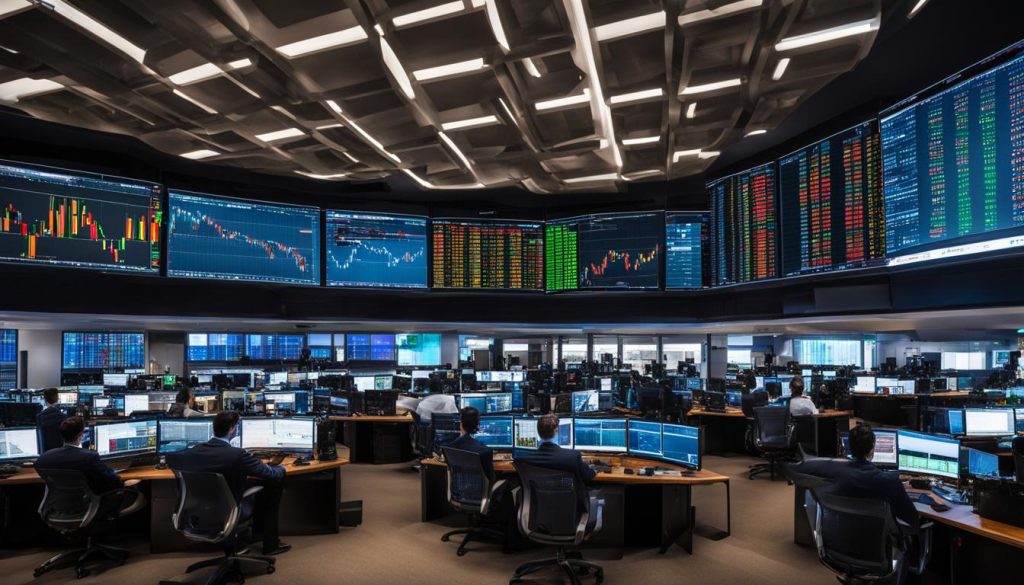The complex and lightning-fast world of high frequency trading (HFT) demands a thorough understanding of not just the strategies that drive profits, but crucially, the sophisticated risk management practices in high frequency trading. As trade orders are executed within mere nanoseconds, often in response to real-time global economic indicators, the scope for error and exposure is significant. At the core of HFT is the need for algorithms – designed to outperform and outpace human decision-making. Yet, these very algorithms come bearing their risks, making high frequency trading risk management an essential spoke in the wheel of financial technology.
With equity markets reveling in the fast-paced trade, holding securities momentarily, high frequency trading necessitates acute attention to risk management. An error in the algorithmic code or a delayed reaction to market change, and the implications can be dire. The financial sector is replete with cautionary tales, such as the notorious 2010 Flash Crash and Knight Capital’s substantial loss. It’s a stark reminder that managing risks in high frequency trading is not just about staying ahead but also about ensuring resilience.
Consistency is key in the delicate balance of high-frequency transactions, where success is measured in fractions of pennies. Therefore, the high frequency trading risk analysis has become an indispensable part of the financial landscape, keeping the markets in check and investor confidence in place. Strategies for mitigating risk play an outsize role in HFT operations, safeguarding against the unforeseen, and securing sustainable operations. Now dive into the high-octane world of HFT and discover how it continues to reshape the nature of trading and risk management in the digital era.
Understanding High Frequency Trading (HFT)
The landscape of finance has undergone a seismic shift due to the evolution of high frequency trading (HFT). This sophisticated form of trading relies heavily on automated trading systems, which have revolutionized how transactions are processed in the equity markets. To comprehend the scale and impact of HFT, it’s essential to explore its origins, the technological advancements that made it possible, and its current status within financial markets.
Evolution of Automated Trading Systems
The journey of automated trading systems spans several decades, beginning with the introduction of electronic exchanges that slowly replaced the manual shout-and-signal method. The transformation from human-centric to computer-based trading didn’t happen overnight; it was rather a gradual transition that meticulously paved the way for the cutting-edge algorithmic trading practices we witness today.
Automating the Financial Markets: From Algorithms to HFT
The shift from traditional floor trading to algorithm-driven systems signified a new era for the securities market. These algorithms were designed not just to execute trades but also to make split-second decisions, considering volumes of market data in the moment. As the capability of algorithms enhanced, they enabled the birth and burgeon of high frequency trading, thus changing the tempo and tactics of equity market transactions.
HFT’s Predominance in Equity Markets
Today, HFT accounts for a substantial share of equity market transactions, reflecting a transformation in market dynamics. This prevalence of HFT necessitates a comprehension of its influence on liquidity, volatility, and the overall ecosystem of global finance. The following table highlights the pivotal transitions and components that contribute to HFT’s current dominance.
| Year | Milestone | Impact on Equity Markets |
|---|---|---|
| 1960s-1970s | Intro of electronic exchanges | Foundation for computer-assisted trades |
| 1980s-1990s | Transition to online terminals | Encouraged remote and automated trading |
| Early 2000s | Rise of algorithmic trading | Precursor to high-frequency strategies |
| 2010s-Present | Expansion of HFT | Majority transactions via HFT; Increased market efficiency and new challenges |
With significant advancements in technology and computing power, the evolution from manual trading to sophisticated automated trading systems capable of engaging in algorithmic trading has laid the groundwork for the era of high frequency trading. This monumental shift promises to continue shaping the future of how financial markets operate.
Managing Risks in High Frequency Trading
Effective strategies for risk management in high frequency trading are essential to navigate the complexities of this fast-paced financial landscape. Implementing robust risk management techniques for high frequency trading is paramount for protecting investments and ensuring long-term operational stability. A comprehensive approach to risk mitigation in high frequency trading includes a multitude of controls and procedures designed to prevent substantial financial losses and maintain market equilibrium.
- Position Limits: By setting caps on the investment amount for each asset, traders can control their exposure to potential losses.
- Stop Loss Orders: This risk control mechanism triggers an automatic sell-off of assets when certain price thresholds are hit, limiting the traders’ downside.
- Volatility-Adaptive Trading Parameters: Real-time adjustments are made to trading strategies to counteract abnormal market conditions and prevent algorithmic errors during periods of high market volatility.
- Liquidity Monitoring: Constant attention to the liquidity of assets allows traders to avoid markets that may induce erratic pricing due to low trading volumes.
- Backtesting and Simulation: Historical data is used to test trading strategies, helping to identify and address potential risks before they impact the market.
- Diversification Strategies: Spreading investments across various assets and markets can safeguard against downturns affecting a particular sector.
- Regulatory Compliance: Adherence to financial regulations is critical for avoiding sanctions and for the sustenance of market integrity.
In addition to these techniques, risk control in high frequency trading crucially depends on sophisticated technology that monitors system performance and detects anomalies in algorithm behavior. This technology ensures that trading activities align with risk tolerance levels and adhere to pre-established safety parameters.
With a constant evolution of market circumstances and regulatory frameworks, HFT entities must remain agile in updating their risk management protocols. While automated systems have brought unprecedented speed and efficiency to market operations, they have also introduced new forms of risks that require diligent oversight and proactive management. As such, the strategies implemented to manage these risks are intricate, constantly refined, and crucial to the successful continuation of high frequency trading operations.
The Role of Speed and Automation in HFT
In the realm of high-frequency trading (HFT), every millisecond is critical for maintaining a competitive edge, as traders who can act the fastest often realize the most profit. The integration of ultra-fast decision making and low-latency infrastructure plays a decisive role in shaping the landscape of financial trading. Thus, to pursue success in HFT, firms must continually strive to enhance the speed at which they assess and execute trades.
Why Milliseconds Matter: Speed as a Competitive Edge
The pursuit of speed in HFT goes beyond sheer performance; it’s about gaining a competitive edge in an environment where opportunities for arbitrage are ephemeral at best. A low-latency infrastructure in HFT is not merely an operational preference; it’s a crucial component that can determine the difference between profit and loss. In this lightning-quick trading arena, even the smallest improvement in speed can result in significant competitive advantages.
High-Frequency Trading’s Reliance on Ultra-Fast Decision Making
Ultra-fast decision making in HFT is entrenched in complex algorithms and innovative technologies that diligently scan the markets for profitable opportunities. With the right tools and connectivity, HFT platforms are able to conduct high frequency trading risk assessment in real-time, swiftly adjusting to market conditions. The ability to act faster than competitors not only enhances profitability but also serves as a protective shield against the inherent risks of the market.
| Aspect | Impact on HFT |
|---|---|
| Speed of Execution | Directly correlates with ability to capitalize on fleeting market opportunities. |
| Algorithm Efficiency | Essential for rapid and accurate decision making; influences success rate of trades. |
| Data Transmission Speed | Critical for real-time analysis and agility; underpinned by a robust low-latency infrastructure. |
| Risk Assessment Process | Must be incredibly fast yet detailed to mitigate potential losses in high-speed trading. |
High Frequency Trading Risk Analysis
The intricate landscape of high frequency trading risk management demands a comprehensive and nuanced approach. A thorough risk analysis in high frequency trading is not only advisable but imperative to the integrity of financial markets. Systemic risk in high frequency trading is a concern that extends beyond individual organizations to the broader market ecosystem. Incidents like the Flash Crash serve as stark reminders of the interconnectedness and vulnerability of global markets to rapid, algorithm-driven events. Constant vigilance and forward-thinking strategies are essential in mitigating such systemic risks.
Assessing HFT risks involves delving into the complex world of algorithms that execute trades at unprecedented speeds. With vast amounts of capital moving in and out of markets within milliseconds, the margin for error is exceedingly narrow. The high profile case involving Knight Capital, where a software glitch resulted in a substantial financial hit, underscores the critical need for stringent algorithmic oversight and the implementation of rigorous testing protocols. In fostering robust risk management strategies, industry players can better anticipate and respond to the unforeseeable challenges that come with operating at the bleeding edge of trading technology.
Moreover, the ephemeral nature of positions held in high frequency trading amplifies the imperative for continuous monitoring and adaptive risk analysis methodologies. As HFT firms harness algorithmic precision to extract profits from minuscule price discrepancies, the assessment of real-time data becomes pivotal in preventing systemic shockwaves. By embracing an iterative process that accommodates rapid changes in market behavior and technological evolution, high frequency trading entities can support market stability while pursuing their profit-driven objectives. In essence, the dynamism of HFT necessitates nothing short of an agile, comprehensive, and persistent approach to risk analysis.
FAQ
Essential strategies for managing risks in high frequency trading include implementing robust position limits, applying stop-loss orders, adjusting trading parameters based on real-time volatility, diligently monitoring liquidity, continuous backtesting of algorithms, strategy diversification, and ensuring regulatory compliance. These strategies are designed to mitigate the potentially significant risks associated with the rapid-paced decision-making environment of HFT.
Risks in high frequency trading are analyzed through a comprehensive approach that takes into account the intricacies of algorithmic trading, the systemic impacts HFT can have on the markets, and the need for constant monitoring. This includes rigorous testing of algorithms, real-time risk assessment, and staying abreast of regulatory changes and technological advancements to mitigate potential financial damages and systemic disruptions.






